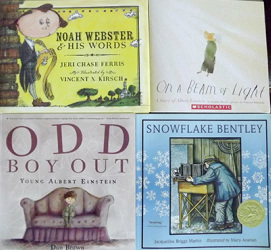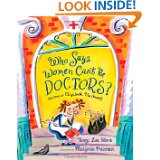 I'm so glad last week's post was helpful to so many of you. To continue on in this subject, I'm going to skip to the endings of picture book biographies, even though it's not the end of January. As picture book biography writers, once we have our beginning sentence, we need to know how the story is going to end, that way we can build the middle. Unfortunately, the Amazon "Look" feature is no help here. But thankfully, I have some picture book biographies in my collection and ones I bought through Amazon Kindle. Just for the record, I'm no expert! I'm writing these posts mainly for my benefit as I learn this genre. I'm going to categorize the endings like I did with the beginnings, although I don't have as many to use. But bear with me, and if you have some to share, please do in the comments, and I can add them. A picture book ending should fulfill a promise that you made in the beginning. If you write about Eli Whitney and the cotton gin in the beginning, then you should end with Eli Whitney and his great invention, not with some other topic like how cotton is grown. It's called coming full circle. And I realized something else, which I'll share at the end. :) I'm first going to list the beginning and then the ending, so you can see how that ending fulfills the promise made in the beginning, plus categorize the ending so you can see ways authors have ended their biographies. Quirky Endings - the ending emphasizes the quirk or special trait that made this person unique Noah Webster and His Words by Jeri Chase Ferris, Houghton Mifflin 2012 Beginning: Noah Webster always knew he was right, and he never got tired of saying so (even if, sometimes, he wasn’t). He was, he said, “full of CON-FI_DENCE” [noun: belief that one is right] from the very beginning. Ending: Noah Webster's words did unite America. He always knew he was right! Odd Boy Out: Young Albert Einstein, by Don Brown, Houghton Mifflin 2004 Beginning: On a sunny, cold Friday in the old city of Ulm, Germany, a baby named Albert Einstein is born. It is March 14, 1879. The joy his family has for the new birth is brief. His grandmother cries, "Much too fat. Much too fat." And his mother fears his head is too big. Ending: For the world, Einstein comes to mean not fat baby, or angry child, or odd boy, but great thinker. Quirk + thanks + review of person's greatness - This ending emphasizes what the person has done, usually because of their quirky trait. Snowflake Bentley by Jacqueline Briggs Martin, Houghton Milfflin 1998 Beginning: In the days when farmers worked with ox and sled and cut the dark with lantern light, there lived a boy who loved snow more than anything else in the world. Ending: Neighbors and strangers have come to know of the icy wonders that land on their own mittens--thanks to Snowflake Bentley. Talks to the Reader Who Says Women Can't Be Doctors? The Story of Elizabeth Blackwell by Tanya Lee Stone, Christy Ottaviano (Henry Holt) 2013 Beginning: I'll bet you’ve met plenty of doctors in your life. And I’ll bet lots of them were women. Well, you might find this hard to believe, but there once was a time when girls weren’t allowed to become doctors. Ending: She had become the first woman doctor in America. Although many people were proud, others were angry. One doctor even wrote, “I hope, for the honor of humanity, that [she]will be the last.” But as you know, she certainly was NOT. On a Beam of Light: The Story of Albert Einstein, by Jennifer Berne, Chronicle 2013 Beginning: Over 100 years ago, as the stars swirled in the sky, as the Earth circled the sun, as the March winds blew through a little town by a river, a baby was born. His parents named him Albert. Ending: But still, Albert left us many big questions. Questions that scientists are working on today. Questions that someday you may answer...by wondering, thinking, and imagining. *This one also ends using Albert's quirk of always asking questions which is introduced in the middle of the book, rather than the beginning. Notice that each book emphasized in some way a quirk or trait that made the person unique for his/her greatness. AND, my realization--the illustrator emphasized that quirk on the book cover! Check it out. See Noah Webster's big head to show his pride, and with On a Beam of Light, Albert is looking at the light, with inquisitiveness, and in Odd Boy Out, Albert is all alone because he's so odd, and Snowflake Bentley is surrounded with snow, and in Who Says Women Can't Be Doctors?, it's obvious there's a GIRL on the cover? So just like when writing picture books, we're told to have a flawed main character with some quirk, the SAME thing is needed in a picture book biography. What makes this person tick? How did the flaw or special trait aid in greatness and fame? QUIRK is my word for the week. What quirk does your character have? How would an illustrator draw it?
16 Comments
1/12/2014 09:56:59 pm
Tina, again this is a super helpful and timely post. I've just finished the terrible first draft of my PB history/biography. And now I'm revising it. Your beginning/ending study is incredibly helpful as I try to make this draft sing.
Reply
1/13/2014 05:05:54 am
I'm just in the beginning stages of creating a non-fiction PB, so I am finding your posts so helpful, Tina. Thanks! Good examples . . .
Reply
1/13/2014 07:03:10 am
I love it!! Yea!
Reply
1/14/2014 03:52:19 am
Perfect! I'd just been wondering about endings. Thanks for posting, Tina! :)
Reply
1/15/2014 11:02:21 am
Tina, I love this. Actually seeing examples helps so much. :-)
Reply
1/17/2014 07:30:27 am
Thanks, Tina! It's really helpful to see all these beginnings and endings together - really helps to distill it down. I like your research style!
Reply
Leave a Reply. |
Tina M. Cho, children's authorI'm a children's author and freelance writer for the educational market. Welcome! Archives
March 2024
Categories
All
|





 RSS Feed
RSS Feed
